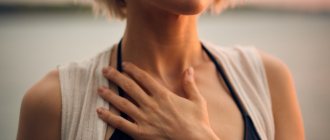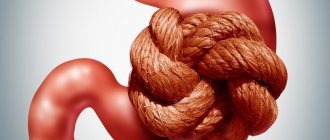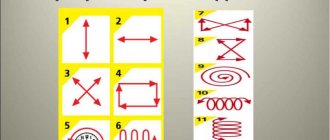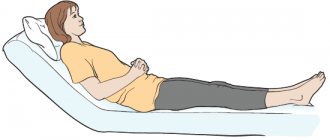Breathing exercises by Strelnikova for bronchitis
Strelnikova’s breathing exercises help in the treatment of bronchitis, pneumonia and other respiratory diseases. Initially, her exercises were created to restore the voices of singers and artists after injuries, but it soon became clear that when performed regularly, breathing exercises promote recovery from bronchitis, correct the patient’s condition with bronchial asthma, and even help alleviate the patient’s condition during a heart attack.
The basics of proper breathing according to Strelnikova:
- Active short inhalation and natural passive exhalation. The air is inhaled through the nose, making a short, strong and noisy movement, and exhaled through the mouth;
- The breathing movement should coincide in time with inhalation;
- Maintain rhythmic breathing according to the rhythm of the march;
- Breathing exercises are performed sitting, lying or standing, depending on the patient’s condition; To increase efficiency, it is recommended to carry them out in the fresh air, even while walking.
Breathing exercises for bronchitis
Breathing exercises are not used as an independent treatment for acute bronchitis, but exercises can be performed within two days of starting antibiotic therapy. Effective Strelnikov gymnastics exercises to ease expectoration and make breathing free:
- Fists. Starting position: standing with your arms down, feet shoulder-width apart, relax your muscles. Take a strong, short breath through your nose, while clenching your hands into a fist. Exhale through the mouth without making any additional effort; during exhalation, the fingers are extended. The exercise is repeated four times in a row, after a break of 5 seconds the next approach is done. You need to do 6 approaches.
- Dropping the load. The exercise is performed from the starting position, standing with feet shoulder-width apart, hands held on the belt, hands clenched into fists. During a short and noisy inhalation, the shoulder muscles are tensed, after which the arms are lowered, while unclenching the fists and stretching out the fingers, as if getting rid of a heavy burden. When exhaling, the lips slightly unclench and return to their original position. The number of approaches is 12, 8 inhalations and exhalations are done in one approach.
- Pumping the ball. Starting position as for the “Fists” exercise. During an active sharp inhalation, the body is tilted forward, the head is lowered, the shoulders are rounded, and the arms are pulled forward and relaxed so that they hang down. In total you need to do twelve approaches, eight bends and breaths in each. The game form of this exercise for children is carried out with a ball, which needs to be inflated during each breath. This will make it easier for the child to learn the correct technique for performing the exercise, and gymnastics will not be a burden to him.
- Cat dance. Starting position - standing with relaxed arms at your sides, feet shoulder-width apart. While inhaling, bend your arms at the elbows, clench your hands into a fist, squat, turning your torso to the left. As you exhale, return to the starting position; on the next inhalation, repeat the exercise with a turn in the other direction. Based on the name of the exercise and the nature of body movements, you can offer children its playful form - while performing it, imagine yourself as a cat stalking prey.
- Big hugs. Starting position - standing with shoulders straightened and legs shoulder-width apart, arms placed in front of the chest, slightly bent at the elbows, palms facing down. During a short noisy inhalation, the fingers squeeze tightly and move the arms behind the back as much as possible, as if in an attempt to hug oneself. As you exhale, take the starting position. With the correct technique, the hands move parallel to one another. Do 12 rounds of 8 inhalations and exhalations.
- Tilts. The starting position is standing with your shoulders back, your feet shoulder-width apart, and your arms lying along your body. As you inhale, bend forward, stretch your arms forward to the level of your knees, and as you exhale, return to your original standing position, but do not freeze, but continue to move your body backwards, bending slightly at the lower back, while moving your arms behind your back. After this, they stand up straight again and take a new breath.
- Head turns. The exercise is performed from the starting position standing, the arms are relaxed along the body, the abdominal muscles are tense, the back is kept straight, the legs are shoulder-width apart. Take a short and intense breath, at the same time turning the head to the left, exhale calmly, returning to the starting position, and immediately take a new breath and turn in the other direction.
- Head tilts. The starting position is the same as for the “Turning the head” exercise. With a sharp and short inhalation, the head is tilted, pressing the ear to the left shoulder, exhale smoothly, return to the starting position and, without pause, inhale again and tilt the head to the right. In total, do twelve approaches of eight inhalations and exhalations in each.
- Tilts the head back and forth. The starting position is the same, while inhaling, tilt the head so that the chin is pressed to the chest, exhale calmly, returning to the starting position. Repeat 12 approaches 8 times, without pausing between inhalations and exhalations in one approach. Head movements should be smooth and calm.
- Fun dance. The exercise is performed from a standing position with relaxed arms and shoulder girdle, legs brought together. As you inhale, take a step forward with your left leg, transferring your body weight to it. The left leg is slightly bent, the right leg is on the toe, the arms bent at the elbows are moved forward and to the left. When exhaling, they return to the starting position. Without a pause, with the next inhalation, take a step with the other leg, repeating the movement of the arms in the opposite direction. As you exhale, return to the starting position.
- Step forward. Starting position as for the “Happy Dance” exercise. During an active and noisy inhalation, the left leg is bent at the knee and pulled towards the stomach, while at the same time squatting slightly on the right leg, and when exhaling, they return to the starting position. During the next inhalation and exhalation, change legs.
- Step back. The starting position is the same as for the “Step Forward” exercise. Now, while inhaling, the leg is pulled back, trying to bend it so that the heel touches the buttock, while simultaneously squatting on the other leg. As you exhale, return to the starting position. The exercise begins with the left leg, and on the next inhalation the leg is changed.
An exercise that allows you to quickly calm down a coughing attack at the first stage of its occurrence: the starting position is standing or sitting, your palms rest freely on your stomach so that the umbilical fossa is located between them. Every time before the cough starts, apply a little pressure with your palms on your stomach from top to bottom, as if trying to “push” the cough to the floor.
After completing a set of breathing exercises, it is recommended to complete the gymnastics with the “Hug your shoulders” and “Pump” exercises. When treating chronic bronchitis and obstructive pulmonary disease, it is recommended to perform all Strelnikova gymnastics exercises daily in the specified order. While performing the exercises, it is necessary to monitor your well-being - gymnastics should not bring discomfort or unpleasant sensations.
Breathing exercises for bronchitis in video format:
Basic rules for charging
If medical research has not been prohibited, then even bedridden patients can perform the exercises. The diagrams can be printed without unnecessary words or explanations. To do this, you must follow a few simple rules:
- The inhalation should be sharp and noisy, the wings of the nose should be adjacent to the septum. Imitate sniffing smoke during a fire.
- Exhalation should be natural, without sudden, forced movements. Otherwise, the risk of hyperventilation increases.
- The rhythm of inhalation and exhalation is important, so it is recommended to use counting.
- The number of repetitions should be a multiple of 4. This is how the load increases.
- Gradually reduce the number of approaches and pauses between them by increasing the number of actions.
The complex consists of 11 exercises; they can be performed at home or in the office, while sitting, standing or lying down. It is important to increase the rhythm gradually, on the first day start with 3 exercises. Over time, reach the completion of the entire complex. To improve the condition of various diseases, as well as prevention and weight loss, it is enough to devote from 7-8 to 26-28 minutes a day to these activities (there are also programs for 19 minutes).
In many cities there are special courses or schools for teaching methods, for example, in Vladimir, where they conduct lessons, train basic and additional movements, and can tell you how many repetitions to do and rest intervals. Also, to improve conditions associated with lung diseases, gymnastic procedures are carried out in salt caves (for example, in St. Petersburg).
Contemporaries and followers developed a number of programs based on basic movements, for example, “24 minutes in unison.” There are similar methods of Buteyko and Frolov, but Strelnikova created a complex that is different from others.
You can also find an accessible description with photos or pictures to master Strelnikov breathing on your own.
Features of working with children
Breathing exercises are of great importance in the treatment of diseases of the respiratory system in children. If treatment is carried out only with medications, the healing process may slow down, since phlegm is not cleared from the respiratory tract in time. The respiratory organs finally finish forming by the age of twelve, so severe bronchitis at an early age can provoke further pathologies and is generally more difficult to treat.
Strelnikova’s gymnastics not only helps to enhance the processes of self-cleaning of the bronchi, but also strengthens the respiratory muscles. A child can perform the exercises together with an adult, so that breathing exercises for bronchitis do not seem tiring and boring to him; classes are conducted in a playful way. Therapeutic gymnastics is practiced only when the child’s condition has stabilized - the exacerbation is over, the body temperature is normal, and at least three days have passed since the start of drug therapy.
Play and strengthen your baby's breathing
If you need to do breathing exercises with a small child, then the main thing is to captivate him with the process, giving the exercises a playful form. So, as a breathing exercise, children can be asked to blow soap bubbles or inflate a balloon, launch sailboats in the bathtub, using their own breath as the wind. Just 10-15 minutes of such exercises daily is enough, and after a few weeks you will notice the first results. The respiratory muscles are strengthened, the inhalation process is normalized and oxygen exchange in the tissues is enhanced, the respiratory organs restore their function.
To consolidate the effect after breathing exercises, it is recommended to carry out a drainage massage - walk with light tapping movements of the palms on the front and back sides of the chest. This stimulates the process of coughing and sputum discharge.
Author of the article:
Mochalov Pavel Alexandrovich |
Doctor of Medical Sciences therapist Education: Moscow Medical Institute named after. I. M. Sechenov, specialty - “General Medicine” in 1991, in 1993 “Occupational diseases”, in 1996 “Therapy”. Our authors
How to quickly relieve a cough
When a person exhales vigorously, including when coughing, the abdominal wall and diaphragm muscles tense. With prolonged intense coughing, the respiratory muscles become overtired and begin to ache. During an attack, press the pillow firmly against your stomach - this will facilitate coughing and slightly reduce pain.
Do not tolerate a painful cough, immediately consult a doctor and begin full treatment.
For example, with an acute or prolonged wet cough, mucolytic drugs (bromhexine and analogues) and expectorants help. They are prescribed for colds, bronchitis and other bronchopulmonary infections. Causes and treatment of cough: what you need to know?











